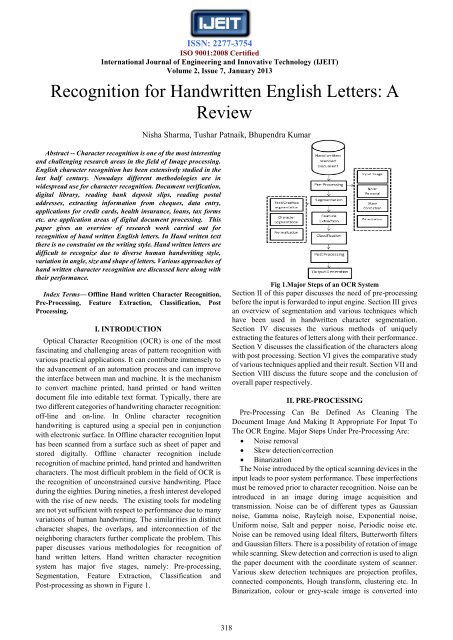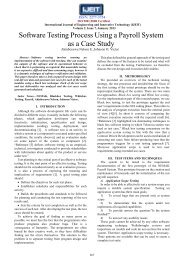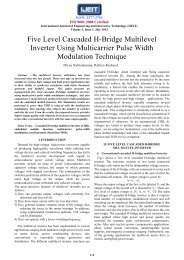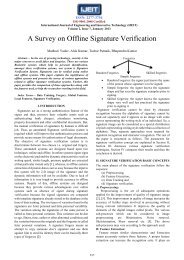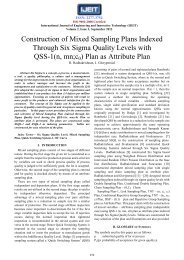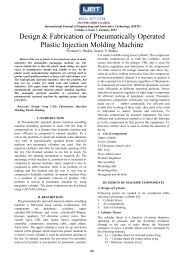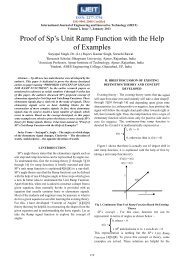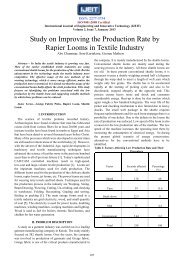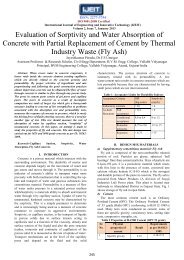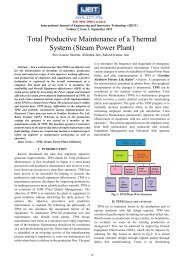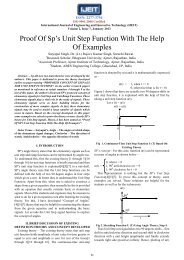Recognition for Handwritten English Letters: A Review - ijeit
Recognition for Handwritten English Letters: A Review - ijeit
Recognition for Handwritten English Letters: A Review - ijeit
You also want an ePaper? Increase the reach of your titles
YUMPU automatically turns print PDFs into web optimized ePapers that Google loves.
ISSN: 2277-3754<br />
ISO 9001:2008 Certified<br />
International Journal of Engineering and Innovative Technology (IJEIT)<br />
Volume 2, Issue 7, January 2013<br />
<strong>Recognition</strong> <strong>for</strong> <strong>Handwritten</strong> <strong>English</strong> <strong>Letters</strong>: A<br />
<strong>Review</strong><br />
Nisha Sharma, Tushar Patnaik, Bhupendra Kumar<br />
Abstract -- Character recognition is one of the most interesting<br />
and challenging research areas in the field of Image processing.<br />
<strong>English</strong> character recognition has been extensively studied in the<br />
last half century. Nowadays different methodologies are in<br />
widespread use <strong>for</strong> character recognition. Document verification,<br />
digital library, reading bank deposit slips, reading postal<br />
addresses, extracting in<strong>for</strong>mation from cheques, data entry,<br />
applications <strong>for</strong> credit cards, health insurance, loans, tax <strong>for</strong>ms<br />
etc. are application areas of digital document processing. This<br />
paper gives an overview of research work carried out <strong>for</strong><br />
recognition of hand written <strong>English</strong> letters. In Hand written text<br />
there is no constraint on the writing style. Hand written letters are<br />
difficult to recognize due to diverse human handwriting style,<br />
variation in angle, size and shape of letters. Various approaches of<br />
hand written character recognition are discussed here along with<br />
their per<strong>for</strong>mance.<br />
Index Terms— Offline Hand written Character <strong>Recognition</strong>,<br />
Pre-Processing, Feature Extraction, Classification, Post<br />
Processing.<br />
I. INTRODUCTION<br />
Optical Character <strong>Recognition</strong> (OCR) is one of the most<br />
fascinating and challenging areas of pattern recognition with<br />
various practical applications. It can contribute immensely to<br />
the advancement of an automation process and can improve<br />
the interface between man and machine. It is the mechanism<br />
to convert machine printed, hand printed or hand written<br />
document file into editable text <strong>for</strong>mat. Typically, there are<br />
two different categories of handwriting character recognition:<br />
off-line and on-line. In Online character recognition<br />
handwriting is captured using a special pen in conjunction<br />
with electronic surface. In Offline character recognition Input<br />
has been scanned from a surface such as sheet of paper and<br />
stored digitally. Offline character recognition include<br />
recognition of machine printed, hand printed and handwritten<br />
characters. The most difficult problem in the field of OCR is<br />
the recognition of unconstrained cursive handwriting. Place<br />
during the eighties. During nineties, a fresh interest developed<br />
with the rise of new needs. The existing tools <strong>for</strong> modeling<br />
are not yet sufficient with respect to per<strong>for</strong>mance due to many<br />
variations of human handwriting. The similarities in distinct<br />
character shapes, the overlaps, and interconnection of the<br />
neighboring characters further complicate the problem. This<br />
paper discusses various methodologies <strong>for</strong> recognition of<br />
hand written letters. Hand written character recognition<br />
system has major five stages, namely: Pre-processing,<br />
Segmentation, Feature Extraction, Classification and<br />
Post-processing as shown in Figure 1.<br />
Fig 1.Major Steps of an OCR System<br />
Section II of this paper discusses the need of pre-processing<br />
be<strong>for</strong>e the input is <strong>for</strong>warded to input engine. Section III gives<br />
an overview of segmentation and various techniques which<br />
have been used in handwritten character segmentation.<br />
Section IV discusses the various methods of uniquely<br />
extracting the features of letters along with their per<strong>for</strong>mance.<br />
Section V discusses the classification of the characters along<br />
with post processing. Section VI gives the comparative study<br />
of various techniques applied and their result. Section VII and<br />
Section VIII discuss the future scope and the conclusion of<br />
overall paper respectively.<br />
II. PRE-PROCESSING<br />
Pre-Processing Can Be Defined As Cleaning The<br />
Document Image And Making It Appropriate For Input To<br />
The OCR Engine. Major Steps Under Pre-Processing Are:<br />
Noise removal<br />
Skew detection/correction<br />
Binarization<br />
The Noise introduced by the optical scanning devices in the<br />
input leads to poor system per<strong>for</strong>mance. These imperfections<br />
must be removed prior to character recognition. Noise can be<br />
introduced in an image during image acquisition and<br />
transmission. Noise can be of different types as Gaussian<br />
noise, Gamma noise, Rayleigh noise, Exponential noise,<br />
Uni<strong>for</strong>m noise, Salt and pepper noise, Periodic noise etc.<br />
Noise can be removed using Ideal filters, Butterworth filters<br />
and Gaussian filters. There is a possibility of rotation of image<br />
while scanning. Skew detection and correction is used to align<br />
the paper document with the coordinate system of scanner.<br />
Various skew detection techniques are projection profiles,<br />
connected components, Hough trans<strong>for</strong>m, clustering etc. In<br />
Binarization, colour or grey-scale image is converted into<br />
318
ISSN: 2277-3754<br />
ISO 9001:2008 Certified<br />
International Journal of Engineering and Innovative Technology (IJEIT)<br />
binary image with the help of thresholding. Binary image can<br />
be achieved using Adaptive thresholding, Global thresholding,<br />
variable thresholding, Ostu’s method etc. Morphological<br />
operations are also used in pre-processing. Dilation and<br />
Erosion are the morphological operations that increase or<br />
decrease the image size. Erosion makes an object smaller by<br />
eroding away the pixels from its edges. Every object pixel that<br />
is touching background pixels is changed into background<br />
pixel. However, dilation makes an object larger by adding<br />
pixels around its edges. Every pixel that is touching an object<br />
pixel is changed into object pixel. Other morphological<br />
operations are opening and closing.<br />
III. SEGMENTATION<br />
Segmentation is needed since handwritten characters<br />
frequently interfere with one another. Common ways in which<br />
characters can interfere include: overlapping, touching,<br />
connected, and intersecting pairs etc. In order to separate text<br />
from graphs, images, line, text/graphics segmentation is<br />
required. The output should be an image consisting of text<br />
only. Character segmentation will separate each character<br />
from another. It is one of the main steps especially in cursive<br />
scripts where characters are connected together. The isolated<br />
characters obtained as a result of character segmentation are<br />
normalized to specific size <strong>for</strong> better accuracy. Features are<br />
extracted from the characters with the same size in order to<br />
provide data uni<strong>for</strong>mity. Christopher E. Dunn and P. S. P.<br />
Wang [5] used a series of region finding, grouping, and<br />
splitting algorithms. Region finding will identify all the<br />
disjoint regions. The pixels are originally labeled On/Off<br />
where “on” signifies the data areas. Image is examined pixel<br />
by pixel until “on” value is found .Once found it is labeled<br />
with new region number and its neighbors are searched <strong>for</strong><br />
additional “on” value. Search proceeds until no “on” value is<br />
found. The result is that all disjoint regions will be identified<br />
and all pixels in any region will be labeled with a unique<br />
number. Grouping deals with the characters which have<br />
separate parts or which are broken. A smallest bounding box<br />
is calculated that completely encloses another region. If <strong>for</strong><br />
any two regions the bounding box of one region completely<br />
encloses another region, then the enclosed region is relabeled<br />
to the value of the enclosing region. Thus, the resulting region<br />
is composed of two disjoint sub-regions. This is helpful <strong>for</strong><br />
connecting regions that have been separated due to noise<br />
.Splitting [5] deals with touching characters. Anshul Mehta<br />
[2] used Heuristic segmentation algorithm which scans the<br />
hand written words to identify the valid segmentation points<br />
between characters. The segmentation is based on locating the<br />
arcs between letters, common in handwritten cursive script.<br />
For this a histogram of vertical pixel density is examined<br />
which may indicate the location of possible segmentation<br />
points in the word. Other character segmentation approaches<br />
[4] are Thinning based method, Contour Fitting method,<br />
Robust Statistical technique, Hypothesis Verification, Shape<br />
Feature Vector method etc.<br />
Volume 2, Issue 7, January 2013<br />
IV. FEATURE EXTRACTION<br />
Feature extraction is finding the set of parameters that<br />
define the shape of a character precisely and uniquely. Feature<br />
extraction [3] methods are classified into three major groups<br />
as:<br />
Statistical features.<br />
Global trans<strong>for</strong>mation and series expansion.<br />
Geometric and topological features.<br />
Statistical features represent the image as statistical<br />
distribution of points. Various methods which use statistical<br />
features are Zoning, Crossings and Distances, Projections etc.<br />
In global trans<strong>for</strong>mation and series expansion various<br />
techniques are Fourier trans<strong>for</strong>m, Gabor trans<strong>for</strong>m, Fourier<br />
Descriptor, wavelets, moments, Karhunen-Loeve expansion<br />
etc. In Geometric and topological features, the structural<br />
features like loops, curves, lines, T-point, cross, opening to<br />
the right, opening to the left etc. are used. The various<br />
categories are coding (freeman chain code), extracting and<br />
counting topological structures, graphs and trees. Geometric<br />
features are used along with fuzzy logic to recognize<br />
characters [7]. Adnan Amin [6] and Puttipong Mahasukhon<br />
[7] used structural in<strong>for</strong>mation to extract features from a<br />
character like Breakpoints, Inflection Point, Cusp Point,<br />
Straight Line, Curve, Open or Close Loop etc. Breakpoint<br />
divides a path into sub paths. It has two possible conditions-<br />
Inflection Point (change in curvature) and Cusp Point (sharp<br />
change in direction).Straight line has two points in sequence<br />
in a path. Open curve is as in letter “S”. Closed curve is as<br />
present in “a”. These segments are given as input to neural<br />
network classifier. Anshul Mehta [2] used Fourier descriptor<br />
<strong>for</strong> extracting unique feature from a character. Initially<br />
boundary is detected, then discrete Fourier coefficient a[k]<br />
and b[k] are calculated <strong>for</strong> 0< k < L-1. Where L is the total<br />
number of boundary points. Fourier descriptor [8] can be used<br />
with one new technique known as Border Transition<br />
technique (BTT).In it each character is partitioned into four<br />
equal quadrants. The scanning and calculation of<br />
black-to-white transition take place in both vertical and<br />
horizontal directions in each quadrant. The average transition<br />
of each direction (horizontal and vertical) in each of the four<br />
quadrants of the box surrounding the character will be<br />
calculated. Rafael M. O [1] used nine modified feature<br />
extraction techniques on a single database. Structural<br />
characteristics consist in extracting histograms and profiles<br />
and combining then into a single feature vector. In modified<br />
edge map an M X N image is thinned and scaled into a 25 X<br />
25 matrix. The Sobel operators are used to extract four<br />
distinct edge maps: horizontal, vertical and two diagonals.<br />
These four maps and the original image are divided into 25<br />
sub-images of 5 X 5 pixels each. The features are obtained<br />
calculating the percentage of black pixels in each sub-image<br />
(25 features per image). The features are combined to <strong>for</strong>m a<br />
single feature vector containing 125 (25 X 5) features. Image<br />
Projections consists of extracting the radial and diagonal<br />
projections. To extract the radial projections, the image must<br />
319
ISSN: 2277-3754<br />
ISO 9001:2008 Certified<br />
International Journal of Engineering and Innovative Technology (IJEIT)<br />
Volume 2, Issue 7, January 2013<br />
first be divided into four quadrants: top, bottom, right and left.<br />
Radial projections are obtained by grouping pixels by its<br />
radial distance to the center of the image in each quadrant<br />
separately. The diagonal projection is computed simply by<br />
grouping pixels by the two diagonal lines. The values of each<br />
projection are normalized to a range [0-1] through the<br />
division by the maximum value. The normalized features are<br />
Concatenated in a single vector containing 128 features. In<br />
Multi Zoning an M x N character image is divided into several<br />
sub-images and the percentage of black pixels in each<br />
Sub-image is used as feature. It is a statistical approach as<br />
features are calculated based on the number of pixels used to<br />
represent an image. Other feature extraction algorithms used<br />
are Concavities Measurement, MAT-based Gradient<br />
Directional features, Gradient Directional features, Median<br />
Gradient features, Camastra 34D features[1].<br />
V. CLASSIFICATION AND POST PROCESSING<br />
The classification is the process of identifying each<br />
character and assigning to it the correct character class. The<br />
classification techniques [9] can be categorized as:<br />
Classical techniques.<br />
Soft computing techniques.<br />
The various classical techniques are Template matching,<br />
Statistical techniques, Structural techniques. Whereas the<br />
various soft computing techniques are Neural networks,<br />
Fuzzy logic, Evolutionary computing techniques. Adnan<br />
Amin and W. H. Wilson [6] used Neural network <strong>for</strong><br />
classification of characters with three layers namely Input<br />
layer, Output layer and Hidden layer. The geometric features<br />
extracted like dot, line, curve or loops are given as input to the<br />
input layer. Each component of the segmented representation<br />
is classified as a dot, line, curve, or loop. In each case, the<br />
characteristics of the component are determined: if a line,<br />
what are its orientation and its size relative to the character<br />
frame - short, medium or long. One input neuron is used to<br />
encode each of these possible choices (short/medium/long)<br />
and each of four possible orientations <strong>for</strong> a line. One input<br />
neuron is used to encode the characteristics of each<br />
component extracted by geometric feature extraction<br />
technique. Neuron has two modes of operations as training<br />
mode and testing mode. In the training mode, the neuron can<br />
be trained to fire (or not), <strong>for</strong> particular input patterns. In the<br />
testing mode, when a taught input pattern is detected at the<br />
input, its associated output becomes the current output. If the<br />
input pattern does not belong in the taught list of input<br />
patterns, the firing rule is used to determine whether to fire or<br />
not. Anshul Mehta, Manisha Srivastava [2] used three<br />
networks <strong>for</strong> the recognition of 26 lower case and 26 upper<br />
case letters as Multilayer Perception (MLP) [2,8], Radial<br />
Basis Function (RBF) and Support Vector Machine<br />
(SVM).Multilayer perception is a feed <strong>for</strong>ward neural<br />
network with one or more layers between input and output<br />
layer. Radial basis function (RBF) networks typically have<br />
three layers: an input layer, a hidden layer with a non-linear<br />
RBF activation function and a linear output layer.<br />
Post-processing mainly consists of two tasks – output string<br />
generation and error detection/correction. Output string<br />
generation will reassemble the strings which have been<br />
separated in the process of segmentation whereas error<br />
detection/correction will correct errors with the help of<br />
dictionary.<br />
VI. COMPARISION TABLE<br />
The major steps of an OCR engine are feature extraction<br />
and classification. The various feature extraction techniques<br />
in combination with various classification techniques along<br />
with their result which have been used by the researchers are<br />
discussed in Table I:<br />
Table I<br />
Author<br />
Anshul Gupta ,<br />
Manisha<br />
Srivastava ,<br />
Chitralekha<br />
Mahanta[2]<br />
Anshul Gupta ,<br />
Manisha<br />
Srivastava ,<br />
Chitralekha<br />
Mahanta[2]<br />
Puttipong<br />
Mahasukhon,<br />
Hossein<br />
Mousavinezhad,<br />
Jeong-Young<br />
Song[7]<br />
Rafael M. O.<br />
Cruz, George D.<br />
C. Cavalcanti and<br />
Tsang Ing Ren[1]<br />
Anshul Gupta ,<br />
Manisha<br />
Srivastava ,<br />
Chitralekha<br />
Mahanta[2]<br />
Yuk Ying Chung,<br />
Man to Wong [8]<br />
Feature<br />
extraction<br />
Method<br />
Fourier<br />
descriptor with<br />
magnitude<br />
Fourier<br />
descriptor with<br />
phase<br />
Geometric<br />
features<br />
Classification<br />
Method<br />
Result<br />
SVM classifier 86.66%<br />
SVM classifier 98.74%<br />
Fuzzy theory 90%<br />
Multi Zoning MLP network 89.67%<br />
Fourier<br />
descriptor with<br />
magnitude and<br />
phase<br />
Fourier<br />
descriptor and<br />
topological<br />
properties<br />
VII. CONCLUSION<br />
SVM classifier 98.04%<br />
MLP with back<br />
propagation<br />
96%<br />
The major approaches used in the field of handwritten<br />
character recognition during the last decade have been<br />
reviewed in this paper. Different pre-processing,<br />
segmentation, feature extraction, classification techniques are<br />
also discussed. Though, various methods <strong>for</strong> treating the<br />
problem of hand written <strong>English</strong> letters have developed in last<br />
two decades, still a lot of research is needed so that a viable<br />
software solution can be made available. The existing OCR<br />
<strong>for</strong> handwritten has very low accuracy. We need an efficient<br />
solution to solve this problem so that overall per<strong>for</strong>mance can<br />
be increased.<br />
320
ISSN: 2277-3754<br />
ISO 9001:2008 Certified<br />
International Journal of Engineering and Innovative Technology (IJEIT)<br />
Volume 2, Issue 7, January 2013<br />
VIII. FUTURE RESEARCH<br />
From 1950’s OCR is an active area of research. Many<br />
techniques <strong>for</strong> recognition of Offline <strong>English</strong> <strong>Handwritten</strong><br />
Characters have been suggested. But still an efficient OCR <strong>for</strong><br />
the recognition of hand written letters does not exist. Few<br />
steps have been taken <strong>for</strong> Hand written and Hand printed<br />
(which is a constrained hand writing) <strong>English</strong> letter<br />
recognition. Various challenges are identified which may<br />
provide more lively interest to the researchers. These<br />
challenges are: difficulty to identify the diverse human writing<br />
styles, different angles of letters, different shapes and size of<br />
letter, pure input quality, low accuracy rate in recognition etc.<br />
Hence, a lot of research work is to be done to solve these<br />
problems.<br />
REFERENCES<br />
[1] Rafael M. O. Cruz, George D. C. Cavalcanti and Tsang Ing Ren<br />
“An Ensemble Classifier For Offline Cursive Character<br />
<strong>Recognition</strong> Using Multiple Feature Extraction Techniques”<br />
IEEE 2010.<br />
[2] Anshul Mehta, Manisha Srivastava, Chitralekha Mahanta<br />
“Offline handwritten character recognition using neural<br />
network” IEEE 2011 International conference on computer<br />
applications and Industrial Electronics.<br />
[3] Oivind Due Trier,Anil K Jain and Torfinn Text “feature<br />
extraction methods <strong>for</strong> character recognition- a survey” 1996<br />
[4] Jayashree R Prashad, Dr. U V kulkarni “Trends in handwriting<br />
recognition” IEEE 2010, Tthird international conference on<br />
emerging trends in engineering and technology.<br />
[5] Christopher E. Dunn and P. S. P. Wang “Character<br />
Segmentation techniques <strong>for</strong> handwritten text-A Survey” IEEE<br />
1992.<br />
[6] Adnan Amin and W. H. Wilson “Hand-Printed Character<br />
<strong>Recognition</strong> System Using Artificial Neural Networks” IEEE<br />
1993.<br />
[7] Puttipong Mahasukhon, Hossein Mousavinezhad,<br />
Jeong-Young Song “Hand-Printed <strong>English</strong> Character<br />
<strong>Recognition</strong> based on Fuzzy Theory”IEEE 2012<br />
[8] Yuk Ying Chung, Man to Wong “handwritten character<br />
recognition by Fourier descriptors and neural network” IEEE<br />
1997, Speech and Image Technologies <strong>for</strong> computing and<br />
telecommunication.<br />
[9] Shabana Mehfuz, Gauri katiyar “Intelligent Systems <strong>for</strong><br />
Off-Line <strong>Handwritten</strong> Character <strong>Recognition</strong>: A <strong>Review</strong>”<br />
International Journal of Emerging Technology and Advanced<br />
Engineering 2012.<br />
[10] Nafiz Arica and Fatos T. Yarman-Vural “An Overview of<br />
Character <strong>Recognition</strong> Focused on Off-Line<br />
Handwriting.”IEEE 2001.<br />
[11] Sameer singh, Adnan Amin “Neural network recognition and<br />
analysis of hand printed letters. IEEE 1998.<br />
Scripts”.<br />
AUTHOR’S PROFILE<br />
Ms. .Nisha Sharma received her B.Tech. Degree<br />
from Punjab Technical University .Currently she is<br />
pursuing her M.Tech in computer science from<br />
Centre <strong>for</strong> development of advance computing<br />
(CDAC), Noida. Her interest area is Image<br />
processing, Algorithms, and Database Management<br />
Systems.<br />
Mr. Tushar Patnaik (Sr. Lecturer/Sr. Project<br />
Engineer) joined CDAC in 1998. He has eleven<br />
years of teaching experience. His interest areas are<br />
Computer Graphics, Multimedia and Database<br />
Management System and Pattern <strong>Recognition</strong>. At<br />
present he is leading the consortium based project<br />
“Development of Robust Document Image<br />
Understanding System <strong>for</strong> Documents in Indian<br />
Mr. Bhupendra Kumar (Senior Technical<br />
Officer) joined CDAC in 2005, he received his<br />
M.Tech. degree from IIIT Allahabad with the<br />
specialization in wireless communication and<br />
computing. His interest areas are Advanced<br />
Image processing, pattern recognition,<br />
computer network, wireless network,<br />
MANETs. Currently he is involved in project<br />
“Development of Robust Document Image<br />
Understanding System <strong>for</strong> Documents in<br />
Indian Scripts”.<br />
321


